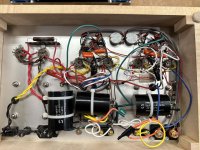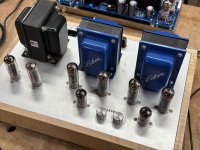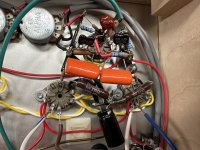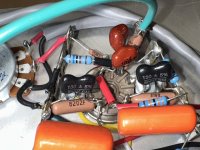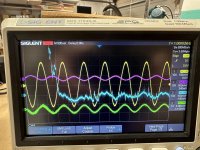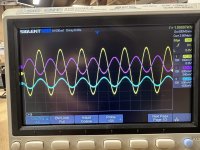I can't find the source of low level noise in EL84 tube amp.
I’m helping a friend fix what looks like a EICO clone … EL84s driven by ECC832.
The amp had worked flawless for 5 years … then we swapped out the old output transformers for new Edcors, ‘cause of impedance issues with his speakers. Everything worked great for about 6 months. Now a low level noise has appeared in one channel.
The noise sounds like someone cleaning the dust of a phonograph cartridge with their finger.
It is a very low amplitude noise. It does not change volume with the program material, the volume pot has no effect on the noise.
It doesn’t matter if anything is plugged into the input or not.
We have swapped all the tubes, it’s not the tubes, the noise stays with the right channel.
I have looked for damaged/burnt parts, found none.
I tried physically moving the parts connected to the ECC832 tube, (using a wood stick and one hand in my pocket) and the noise changed. Not while touching any parts, but after playing with them the noise changed from fairly constant, to very intermittent … quiet for 10 seconds, then an 1/2 second noise event, then 20 seconds silence, then 1/4 second noise event.
While I”m playing around with moving leads and parts, the noise doesn’t change (I can’t find the culprit connection/part)
The point to point connections around the ECC832 tube are very tight, and I wonder if they are somehow affecting the sockets ability to grab the tube pins effectively.
Should I consider replacing the tube socket?
It sounds like a cold connection somewhere … if I knew more I might be able to zero in on which tube pin or component.
Any help in how to proceed would help.
Thanks
I’m helping a friend fix what looks like a EICO clone … EL84s driven by ECC832.
The amp had worked flawless for 5 years … then we swapped out the old output transformers for new Edcors, ‘cause of impedance issues with his speakers. Everything worked great for about 6 months. Now a low level noise has appeared in one channel.
The noise sounds like someone cleaning the dust of a phonograph cartridge with their finger.
It is a very low amplitude noise. It does not change volume with the program material, the volume pot has no effect on the noise.
It doesn’t matter if anything is plugged into the input or not.
We have swapped all the tubes, it’s not the tubes, the noise stays with the right channel.
I have looked for damaged/burnt parts, found none.
I tried physically moving the parts connected to the ECC832 tube, (using a wood stick and one hand in my pocket) and the noise changed. Not while touching any parts, but after playing with them the noise changed from fairly constant, to very intermittent … quiet for 10 seconds, then an 1/2 second noise event, then 20 seconds silence, then 1/4 second noise event.
While I”m playing around with moving leads and parts, the noise doesn’t change (I can’t find the culprit connection/part)
The point to point connections around the ECC832 tube are very tight, and I wonder if they are somehow affecting the sockets ability to grab the tube pins effectively.
Should I consider replacing the tube socket?
It sounds like a cold connection somewhere … if I knew more I might be able to zero in on which tube pin or component.
Any help in how to proceed would help.
Thanks
Attachments
Last edited:
I suspect a resistor.
There is 4 of them that could be replaced :
330k ( plate resistor first triode)
82 k x 2 ( resistors for the concertina plate & catode
and finally 1.6k catode first triode.
Start with the 330
There is 4 of them that could be replaced :
330k ( plate resistor first triode)
82 k x 2 ( resistors for the concertina plate & catode
and finally 1.6k catode first triode.
Start with the 330
I would try some new front end tubes. They look like JJ's in there. Probably time for them to go. 🙂
I'd be on the hunt for some NOS 12DW7's.
jeff
I'd be on the hunt for some NOS 12DW7's.
jeff
Last edited:
Check to see if the input tube grid is at 0V.
Check to see if the output tubes grids are at 0V.
Check to see what the noise looks like on a scope.
Intermittent oscillation? Bursting oscillation?
Check to see if there is Rosin between the socket tabs.
Clean with Alcohol (Freon is forbidden by law).
Check to see if the output tubes grids are at 0V.
Check to see what the noise looks like on a scope.
Intermittent oscillation? Bursting oscillation?
Check to see if there is Rosin between the socket tabs.
Clean with Alcohol (Freon is forbidden by law).
In addition to the stick, freeze spray can be useful, if targeted at only one part at a time.
If the noise goes away when the input tube is removed, that exempts the output stage.
If you replace any resistors (Dales are unlikely to need it), you may as well replace
the tube socket at the same time. Could be either.
There should always be strain relief on component leads, for several reasons.
You may be seeing one of the reasons.
If the noise goes away when the input tube is removed, that exempts the output stage.
If you replace any resistors (Dales are unlikely to need it), you may as well replace
the tube socket at the same time. Could be either.
There should always be strain relief on component leads, for several reasons.
You may be seeing one of the reasons.
Last edited:
Lots of good advice here. I cannot add anything useful other than to suggest you follow the advice, especially on potentially noisy resistors.
Do you remember what part you poked with that sharp stick when the noise changed?
Do you remember what part you poked with that sharp stick when the noise changed?
I found the source of the noise.
Bad mica capacitor between phase inverter and EL84 tube on the high voltage side.
I had first replaced both the tube socket, and all the resistors around the input tube, thinking bad resistor or no slack in tube socket because of tight components. Still noisy. Replacing random components is not the way to go.
Then I broke down and bought an oscilloscope. I've often wanted one, and this was the perfect excuse.
I first removed the feedback loop, so I wouldn't see any noise being re-inserted back into the system. I then sent a 1 khz sine wave thru the input, and started walking down the signal path to see where the noise started. I immediately found where the problem was, and then zeroed in on which component.
In the attached traces, image 2 is the good channel, showing the source signal (yellow) and the two inputs to the EL84 tubes. (output from phase inverter - red and blue plots) everything looks groovey.
The first image shows the bad, noisy channel. Again the source signal in yellow, and the red and blue are the outputs of the phase inverter, inputs to EL84 tubes. Notice the blue plot is full of noise, red plot is not. The blue plot was on the high voltage side of the phase inverter output. The green plot is the input source signal after the volume pot. (not important)
I replaced the cap now no more noise.
Scopes are invaluable for debugging audio equipment.
Thanks to all for the help.
Bad mica capacitor between phase inverter and EL84 tube on the high voltage side.
I had first replaced both the tube socket, and all the resistors around the input tube, thinking bad resistor or no slack in tube socket because of tight components. Still noisy. Replacing random components is not the way to go.
Then I broke down and bought an oscilloscope. I've often wanted one, and this was the perfect excuse.
I first removed the feedback loop, so I wouldn't see any noise being re-inserted back into the system. I then sent a 1 khz sine wave thru the input, and started walking down the signal path to see where the noise started. I immediately found where the problem was, and then zeroed in on which component.
In the attached traces, image 2 is the good channel, showing the source signal (yellow) and the two inputs to the EL84 tubes. (output from phase inverter - red and blue plots) everything looks groovey.
The first image shows the bad, noisy channel. Again the source signal in yellow, and the red and blue are the outputs of the phase inverter, inputs to EL84 tubes. Notice the blue plot is full of noise, red plot is not. The blue plot was on the high voltage side of the phase inverter output. The green plot is the input source signal after the volume pot. (not important)
I replaced the cap now no more noise.
Scopes are invaluable for debugging audio equipment.
Thanks to all for the help.
Attachments
And C7 and C13 too?
C5, C7, C11, and C13 all should all use the same kind of capacitor (material/technology),
and they should have matched capacitance value, or the high frequency drive to the output stages will be different.
They each have exactly the same DC voltage (quiescent voltage) across them.
C5, C7, C11, and C13 all should all use the same kind of capacitor (material/technology),
and they should have matched capacitance value, or the high frequency drive to the output stages will be different.
They each have exactly the same DC voltage (quiescent voltage) across them.
- Home
- Amplifiers
- Tubes / Valves
- I need help finding Noise in EL84 amp
